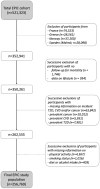On the use of the healthy lifestyle index to investigate specific disease outcomes
- PMID: 39009699
- PMCID: PMC11250810
- DOI: 10.1038/s41598-024-66772-w
On the use of the healthy lifestyle index to investigate specific disease outcomes
Abstract
The healthy lifestyle index (HLI), defined as the unweighted sum of individual lifestyle components, was used to investigate the combined role of lifestyle factors on health-related outcomes. We introduced weighted outcome-specific versions of the HLI, where individual lifestyle components were weighted according to their associations with disease outcomes. Within the European Prospective Investigation into Cancer and Nutrition (EPIC), we examined the association between the standard and the outcome-specific HLIs and the risk of T2D, CVD, cancer, and all-cause premature mortality. Estimates of the hazard ratios (HRs), the Harrell's C-index and the population attributable fractions (PAFs) were compared. For T2D, the HR for 1-SD increase of the standard and T2D-specific HLI were 0.66 (95% CI: 0.64, 0.67) and 0.43 (0.42, 0.44), respectively, and the C-index were 0.63 (0.62, 0.64) and 0.72 (0.72, 0.73). Similar, yet less pronounced differences in HR and C-index were observed for standard and outcome-specific estimates for cancer, CVD and all-cause mortality. PAF estimates for mortality before age 80 were 57% (55%, 58%) and 33% (32%, 34%) for standard and mortality-specific HLI, respectively. The use of outcome-specific HLI could improve the assessment of the role of lifestyle factors on disease outcomes, thus enhancing the definition of public health recommendations.
Keywords: Cancer; Cardiovascular diseases; Composite score; Healthy lifestyle index; Lifestyle factors; Mortality; Type 2 diabetes.
© 2024. The Author(s).
Conflict of interest statement
The authors declare no competing interests.
Figures




References
-
- Board I of M (US) and NRC (US) NCP, Curry SJ, Byers T, Hewitt M. Lifestyle Behaviors Contributing to the Burden of Cancer [Internet]. National Academies Press (US); 2003 [cited 2019 Oct 17]. Available from: https://www.ncbi.nlm.nih.gov/books/NBK223925/
MeSH terms
Grants and funding
LinkOut - more resources
Full Text Sources
Medical

